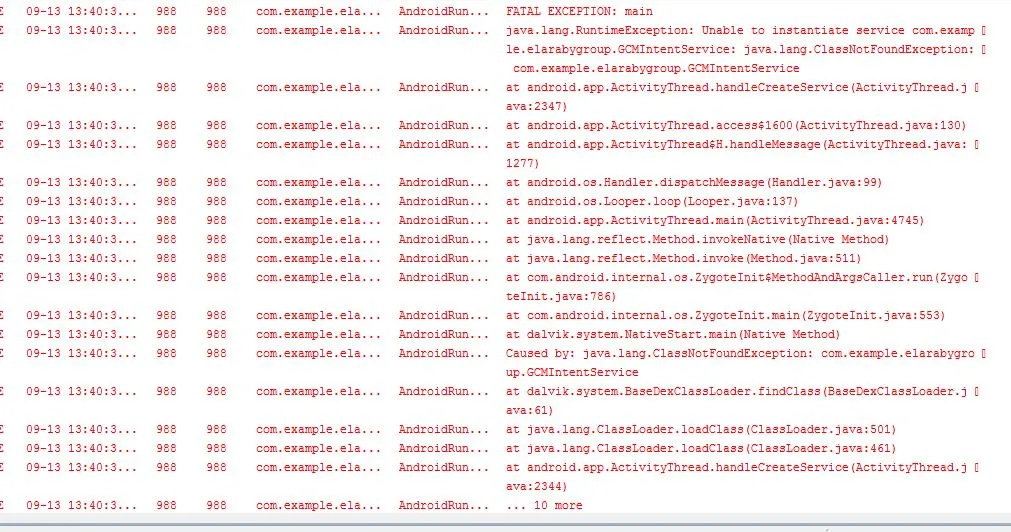我在我的应用程序中使用了GCM服务,在进行更多的研究后,参考了Stack Overflow成员的代码,当我尝试在模拟器上测试代码时,我没有找到任何注册信息告诉我我的模拟器已注册。同时我也创建了Google API账户以接收任何报告,但是我没有找到任何信息。所以我需要你的帮助:
1- 请检查我的代码,并在出现错误时给我反馈一个完整的示例:
<manifest xmlns:android="http://schemas.android.com/apk/res/android"
package="com.example.elarabygroup"
android:versionCode="1"
android:versionName="1.0" >
<uses-sdk
android:minSdkVersion="8"
android:targetSdkVersion="15" />
<permission
android:name="com.example.elarabygroup.permission.C2D_MESSAGE"
android:protectionLevel="signature" />
<uses-permission android:name="com.example.elarabygroup.permission.C2D_MESSAGE" />
<uses-permission android:name="android.permission.INTERNET" />
<uses-permission android:name="android.permission.ACCESS_NETWORK_STATE" />
<uses-permission android:name="android.permission.GET_ACCOUNTS" />
<uses-permission android:name="android.permission.WAKE_LOCK" />
<uses-permission android:name="com.google.android.c2dm.permission.RECEIVE" />
<uses-permission android:name="android.permission.WRITE_SETTINGS" />
<uses-permission android:name="android.permission.ACCESS_WIFI_STATE" />
<application
android:icon="@drawable/ic_launcher"
android:label="@string/app_name"
android:theme="@style/AppTheme" >
<activity
android:name=".ElarabyGroup"
android:label="@string/title_activity_elaraby_group" >
<intent-filter>
<action android:name="android.intent.action.MAIN" />
<category android:name="android.intent.category.LAUNCHER" />
</intent-filter>
</activity>
<receiver
android:name="com.google.android.gcm.GCMBroadcastReceiver"
android:permission="com.google.android.c2dm.permission.SEND" >
<intent-filter>
<action android:name="com.google.android.c2dm.intent.RECEIVE" />
<action android:name="com.google.android.c2dm.intent.REGISTRATION" />
<category android:name="com.example.elarabygroup" />
</intent-filter>
</receiver>
<service android:name=".GCMIntentService" />
<!--
android:name=".GCMIntentService"
android:enabled="true" />
-->
</application>
</manifest>
package com.example.elarabygroup;
import android.app.Activity;
import android.app.AlertDialog;
import android.app.PendingIntent;
import android.content.BroadcastReceiver;
import android.content.Context;
import android.content.Intent;
import android.net.ConnectivityManager;
import android.net.NetworkInfo;
import android.net.Uri;
import android.os.Bundle;
import android.util.Log;
import android.webkit.WebView;
import com.google.android.gcm.GCMRegistrar;
public class ElarabyGroup extends Activity {
private String TAG;
private String SENDER_ID = "222874571774";
private WebView webView;
@Override
public void onCreate(Bundle savedInstanceState) {
super.onCreate(savedInstanceState);
setContentView(R.layout.activity_elaraby_group);
try {
Intent registrationIntent = new Intent(
"com.google.android.c2dm.intent.REGISTER");
/* Registering for GCM /An Android application needs to register with GCM servers before it can receive messages*/
registrationIntent.putExtra("app",
PendingIntent.getBroadcast(this, 0, new Intent(), 0));
registrationIntent.putExtra("sender", SENDER_ID);
startService(registrationIntent);
Log.i(TAG, "[checkNotifRegistration] checkDevice");
GCMRegistrar.checkDevice(this);
Log.i(TAG, "[checkNotifRegistration] checkManifest");
GCMRegistrar.checkManifest(this);
if (GCMRegistrar.isRegistered(this)) {
Log.i(TAG,
"[checkNotifRegistration] reg id : "
+ GCMRegistrar.getRegistrationId(this));
}
final String regId = GCMRegistrar.getRegistrationId(this);
if (regId.equals("")) {
// SENDER_ID is my project id into google account url
GCMRegistrar.register(this, SENDER_ID);
Log.i(TAG,
"[checkNotifRegistration] reg id : "
+ GCMRegistrar.getRegistrationId(this));
} else {
Log.i(TAG, "[checkNotifRegistration] already registered as : "
+ regId);
}
} catch (Exception e) {
Log.e(TAG, "[checkNotifRegistration] Exception : " + e.getMessage());
e.printStackTrace();
}
/*
* GCMRegistrar.checkDevice(this); GCMRegistrar.checkManifest(this);
*
*
* final String regId = GCMRegistrar.getRegistrationId(this); if
* (regId.equals("")) { GCMRegistrar.register(this, "1111111111"); }
* else { Log.v(TAG, "Already registered"); }
*/
try {
ConnectivityManager con = (ConnectivityManager) getSystemService(Context.CONNECTIVITY_SERVICE);
if (con.getNetworkInfo(0).getState() == NetworkInfo.State.DISCONNECTED
&& con.getNetworkInfo(1).getState() == NetworkInfo.State.DISCONNECTED) {
AlertDialog.Builder builder = new AlertDialog.Builder(this);
builder.setMessage("No Internet connection");
AlertDialog alert = builder.create();
alert.show();
} else
{
webView = (WebView) findViewById(R.id.webView1);
webView.getSettings().setJavaScriptEnabled(true);
webView.loadUrl("http://m.elarabygroup.com");
}
} catch (Exception e) {
AlertDialog.Builder builder = new AlertDialog.Builder(this);
builder.setMessage(e.getMessage().toString());
AlertDialog alert = builder.create();
String url = "http://m.elarabygroup.com/";
Intent i = new Intent(Intent.ACTION_VIEW);
i.setData(Uri.parse(url));
startActivity(i);
}
}
/*
public class MyBroadcastReceiver extends BroadcastReceiver {
@Override
public final void onReceive(Context context, Intent intent) {
GCMIntenetService.runIntentInService(context, intent);
setResult(Activity.RESULT_OK, null, null);
}
}
*/
}
/*
* @Override public boolean onCreateOptionsMenu(Menu menu) {
* getMenuInflater().inflate(R.menu.activity_elaraby_group, menu); return true;
* } }
*/
package com.example.elarabygroup;
import com.google.android.gcm.GCMBaseIntentService;
import com.google.android.gcm.GCMRegistrar;
import android.content.Context;
import android.content.Intent;
import android.os.PowerManager;
import android.provider.Settings.Secure;
import android.util.Log;
public class GCMIntenetService extends GCMBaseIntentService {
private static String GCM_SENDER_ID = "1111111111111";
public GCMIntenetService() {
super();
}
@Override
protected void onRegistered(Context context, String registrationId) {
Log.i(TAG, "Device registered: regId = " + registrationId);
GCMRegistrar.setRegisteredOnServer(context, true);
}
@Override
protected void onUnregistered(Context context, String registrationId) {
Log.i(TAG, "Device unregistered");
if (GCMRegistrar.isRegisteredOnServer(context)) {
String regId = "";
Log.i(TAG, "unregistering device (regId = " + regId + ")");
GCMRegistrar.setRegisteredOnServer(context, false);
} else {
// This callback results from the call to unregister made on
// ServerUtilities when the registration to the server failed.
Log.i(TAG, "Ignoring unregister callback");
}
}
@Override
protected void onError(Context context, String errorId) {
// push error processing
}
@Override
protected void onMessage(Context arg0, Intent arg1) {
Log.i(TAG, "Received message");
Log.i(TAG, "EXTRAS" + arg1.getExtras());
// String message = getString(R.string.gcm_message);
generateNotification(arg0,
arg1.getStringExtra("Please download our new updates"));
// notifies user about message
}
private void generateNotification(Context arg0, String stringExtra) {
// TODO Auto-generated method stub
}
public static void registerInGCMService(Context context) {
GCM_SENDER_ID = Secure.getString(context.getContentResolver(),
Secure.ANDROID_ID);
if (!checkIsGCMServiceAvailable(context)) {
return;
}
final String regId = GCMRegistrar.getRegistrationId(context);
if (regId.equals("")) {
try {
GCMRegistrar.register(context, GCM_SENDER_ID);
} catch (Exception ex) {
}
} else {
// Already registered
}
}
public static boolean checkIsGCMServiceAvailable(Context context) {
try {
GCMRegistrar.checkDevice(context);
GCMRegistrar.checkManifest(context);
return true;
} catch (Throwable th) {
return false;
}
}
}
我已经附上了我的日志记录信息。
2- 我的谷歌API账户状态如何?
服务 状态 适用于Android的Google云消息传递 没有已知问题

